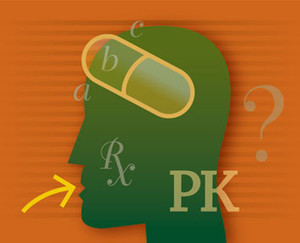A requirement for registration of a biosimilar is to demonstrate pharmacokinetic (PK) similarity with the reference product. A population PK model approach is an excellent method for assessing PK similarity, in contrast to the classical one, because it allows comparison of PK properties through the inclusion of sparse data that improves the power to detect any potential differences between the biosimilar and the reference product. Furthermore, the population approach allows quantification of the inter-product and inter-subject variability of PK parameters and identification of covariate factors (demographic, pathophysiological, environmental or concomitant drugs) that influence drug availability [1].
PK and PD comparison between rituximab biosimilar RTXM83 and rituximab in diffuse large B-cell lymphoma patients
Biosimilars/Research
|
Posted 23/03/2018
 0
Post your comment
0
Post your comment

A randomized, double-blind, phase III clinical study (RTXM83-AC-01-11) was carried out in patients with diffuse large B‑cell lymphoma (DLBCL) to compare the proposed rituximab biosimilar RTXMX83 and its reference product MabThera (rituximab), both in combination with the CHOP chemotherapy regimen (cyclophosphamide, doxorubicin, vincristine and prednisone), every 3 weeks, for 6 cycles (NCT02268045). As a novelty for the PK comparability exercise, the PK similarity of RTXM83 and MabThera was assessed by comparing the predicted serum concentrations over time derived from a population PK model [2]. In parallel, the clinical study allowed the comparison of the pharmacodynamics (PD), immunogenicity, efficacy and safety profile between RTXM83 and its reference product in the same population of patients.
In total, 251 DLBCL patients selected from 58 research sites in 12 countries participated in the PK analysis and a total of 5,341 serum concentrations were available during the 6 cycles of treatment for the population PK analysis.
According to Candelaria et al., the study [2] met the criteria for PK similarity on the primary PK endpoints (area under the concentration-time curve [AUC] and the maximum serum concentration [Cmax]) at Cycle 1 and at steady-state (Cycle 6) and the 90% confidence intervals for all pairwise comparisons were within the predefined bioequivalence interval of 0.80 to 1.25 [3, 4]. Furthermore, the comparison analysis of the individual PK parameters (clearance and volume of distribution) derived from the developed model showed that RTXM83 PK and its associated variability were similar to the reference product, after single and repeated infusions of rituximab. Likewise, the CD20+ and CD19+ B-cells depletion, length of suppression or time to recovery to normal B-cells in peripheral blood were similar in both treatment arms. The overall anti-drug antibody (ADA) incidence in the studied population was low and similar in both drugs and had no impact in the PK/PD profile. Moreover, the results of the comparability exercise for the efficacy and safety between RTXM83 and MabThera in the study patients were in line with PK and PD findings, supporting the claimed biosimilarity of RTXM83 with its reference product.
Candelaria et al. concluded that the use of a non-linear mixed effect modelling population approach when assessing the PK similarity between RTXM83 and the reference product, facilitated the inclusion of sparse data improving the power to detect any potential differences between both drugs, and can be considered a valid method to assess similarity [2].
Abstracted by Ana Del Campo, Madrid, Spain.
Conflict of interest
Several of the authors of the research paper [2] are employees of mAbxience Research or have served in a consultant/advisory role or have received research funding from mAbxience Research. For full details of the authors’ conflict of interest, see the research paper [2].
Related article
Biosimilars of rituximab
References
1. U.S. Food and Drug Administration. Guidance for industry. Population pharmacokinetics. February 1999 [homepage on the Internet]. [cited 2018 Mar 23]. Available from: www.fda.gov/downloads/Drugs/GuidanceComplianceRegulatoryInformation/Guidances/UCM072137.pdf
2. Candelaria M, Gonzalez D, Fernández Gómez FJ, Paravisini A, Del Campo García A, Pérez L, Miguel-Lillo B, Millán S. Comparative assessment of pharmacokinetics, and pharmacodynamics between RTXM83™, a rituximab biosimilar, and rituximab in diffuse large B-cell lymphoma patients: a population PK model approach. Cancer Chemother Pharmacol. 2018;81(3):515-27.
3. European Medicines Agency. Guideline on similar biological medicinal products. (CHMP/437/04 Rev 1). October 2014 [homepage on the Internet]. [cited 2018 Mar 23]. Available from: www.ema.europa.eu/docs/en_GB/document_library/Scientific_guideline/2014/10/WC500176768.pdf.
4. U.S. Food and Drug Administration. Guidance for industry. Clinical pharmacology data to support a demonstration of biosimilarity to a reference product. December 2016 [homepage on the Internet]. [cited 2018 Mar 23]. Available from: www.fda.gov/downloads/drugs/guidancecomplianceregulatoryinformation/guidances/ucm397017.pdf
Permission granted to reproduce for personal and non-commercial use only. All other reproduction, copy or reprinting of all or part of any ‘Content’ found on this website is strictly prohibited without the prior consent of the publisher. Contact the publisher to obtain permission before redistributing.
Copyright – Unless otherwise stated all contents of this website are © 2018 Pro Pharma Communications International. All Rights Reserved.
General
Samsung Bioepis wins Pyzchiva case; Regeneron patent rulings threaten foreign biosimilars
Chinese biosimilars go global: growth, partnerships, and challenges
What is the future for the US biosimilar interchangeability designation

Biosimilars/Research Posted 05/06/2025
Biosimilar clinical efficacy studies: are they still necessary?

Biosimilars/Research Posted 27/05/2025
The best selling biotechnology drugs of 2008: the next biosimilars targets








Post your comment